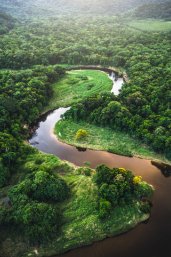Statistical paradox obscures positive relationship between biodiversity and carbon storage
Conservationists have long been hoping for it: a positive relationship between biodiversity and CO2 storage in tropical forests. If you can protect a forest that stores a lot of CO2 and is also home to many different plant species, you can then kill two birds with one stone. Although scientists suspected such a relationship existed, it seemed elusive. Until now: researchers at Utrecht University showed that there is indeed a positive relationship between biodiversity and carbon storage, but at large scales this relationship is obscured by a statistical paradox. Their paper was published earlier this month in the scientific journal Scientific Reports.

Every study on the relationship between species richness and carbon storage in tropical forests - and there are quite a few - reported a different result,
says Gijs Steur, researcher at the Utrecht University Botanic Gardens and lead author of the new study. In some cases, scientists found a positive relationship, while in other cases they found no relationship at all. In rare cases, even a negative relationship was found! Results from my earlier research already suggested that you cannot simply lump data together from forests that are greatly separated geographically. Now we also know why this can be so dangerous.
Biogeographical differences
Together with a large group of researchers, including Utrecht University colleagues Pita Verweij and René Verburg, Steur analysed the Amazon forests. By working with a large group of researchers, we were able to create a large dataset of forest inventories from across the Amazon biome, representing multiple biogeographical regions,
he explains. Within each biogeographical region of the Amazon, the researchers found a positive relationship between biodiversity - in this case the number of tree species - and the amount of carbon storage.
If carbon-rich forests are protected, it appears we can also protect a large part of the tree diversity at the same time.
But when we lumped all the regions together, paradoxically we couldn't find any relationship at all. In statistics, such a phenomenon is known as a Simpson Paradox, named after the statistician Simpson.
Steur and colleagues found that the Simpson Paradox only occurred on the scale of the whole Amazon, but not within the biogeographical regions. Apparently, when you lump subregions within a biogeographical region together, the differences are still too small to cause a paradox,
discovered Steur.
Hope for conservationists
Previous researchers likely did not fully recognise that tropical forests can differ considerably across a large geographical scale, despite environmental variables such as temperature and rainfall being relatively similar,
explains Steur. I suspect that the differences between the regions originate from differences in species composition - which tree species are present and what characteristics they have. This will be the focus of our follow-up research. In the meantime, we have shown that there is hope for conservationists in the Amazon: if carbon-rich forests are protected, we can also protect a large part of the tree diversity at the same time.
Publication
Steur, G., ter Steege, H., Verburg, R.W. et al. Relationships between species richness and ecosystem services in Amazonian forests strongly influenced by biogeographical strata and forest types. Sci Rep 12, 5960 (2022). https://doi.org/10.1038/s41598-022-09786-6.
Steur's PhD research was financed in part by the NWO-UU Graduate Programme Nature Conservation, Management and Restoration and is being continued by Steur at the Utrecht University Botanic Gardens, where he is a curator as well as a researcher. Last year, Steur published a paper showing that the current conservation policies for tropical forests do not properly take all ecosystem services into account.
On Friday 8 July 2022, Steur will defend his thesis during a public dissertation at Utrecht University.

